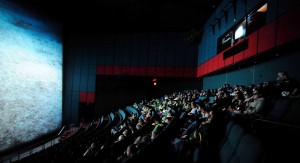
“Our contract with IMAX was ending,” Brohi explained. “We knew we couldn’t do a whole lot about the attendance, but we knew we could do something about the operating expenses.”
After extensive research, including a trip Moody Gardens right before the Digital Cinema Symposium in January 2012, Brohi and her team decided they needed to convert the giant screen at the HMNS to digital. Although the number of visitors has not changed dramatically in the year following the installation of the digital projection system, the theater’s operating costs are way down, the library of content available is much larger, and alternative events are now possible.
Last week at the Giant Screen Cinema Association Conference in Ottawa, Brohi and two of her peers presented case studies of how their museum’s giant screen theaters made the conversion from 15/70 film to digital. “Making the Case for Digital” was moderated by Paul Fraser, the president of Blaze Digital Cinema Works, and comes at a good time. Fraser noted that of the approximately 250 large-format institutional and commercial theaters that program documentaries on a regular basis, 179 (72 percent) are still using film. (This does not include the roughly 100 giant screen dome theaters that are equipped with digital systems). Those managing theaters that continue to show 15/70 film are wondering when and how they are going to make the inevitable transition to digital.
Each of the three panelists outlined the scenario before and after the switch at their theater and each represented a different scenario. Brohi described how the HMNS replaced its IMAX film system with a Barco 4K digital system featuring a Qube Cinema server. Richard Cox, the information service manager of the Clark Planetarium in Salt Lake City, Utah, talked about their replacement of the theater’s IMAX film system with an IMAX digital system. Laurent Dondey, the CEO at La Géode in Paris, outlined how they added a Barco digital flatscreen system to its dome theater, while retaining its IMAX film system.

The decline in attendance that Brohi witnessed is an industry-wide trend. Cox said that the Clark Planetarium had seen visitor numbers decline from 242,000 in 2003 to 158,500 in 2009, before they made the decision to go digital. Dondey noted that attendance at La Géode had peaked at one million visitors for six years in a row before dipping, especially notably between 1999-2001 and then after, and presumably because of, 9/11.
“We were, like most [giant screen theaters], looking at declining attendance, declining revenues and the changing marketplace,” Cox said. “We had thought about and talked about what could we do to improve our institution to get it back to where we wanted to go.”
In January 2010, the Clark Planetarium received a proposal from a local multiplex group offering to assist them to bring in and show major motion picture content. Cox hoped this would boost attendance.
“The reasons we decided to go ahead and make a change was because, one, the neighbors asked us,” Cox said. “They said, ‘We can help you with the Hollywood content.’ Two, we were a little nervous about what we perceived was a declining number of quality documentary films coming out. And we had some money.”
For Dondey at La Géode, he saw digital as a way to overcome an image problem. “We had declining attendance. We had the problem of image. The place was called an old-fashioned ‘Sleeping Beauty,’” Dondey said. “There was a true problem of modernity and moving to digital was to connect to the world.”
But they were also looking for live and rotating content, which is only possible with digital, and had a fear of missing out on new digital content for domes.
“You all know that the DMR revolution was very much flat-screen oriented and dome productions were less and less,” Dondey explained. “The giant screen market was going flat screen. And so, there was a lack of independence, only relying on one or two sources. And in 2007 the price of a digital projector was becoming affordable.”

Cox and his team stayed with IMAX and didn’t undertake any kind of competitive bid for the conversion. The Clark Planetarium was closed for its upgrade in early October 2010 and reopened in mid-November with Harry Potter and the Deathly Hallows – Part 1.
“We were happy with the IMAX name as our 15/70 provider,” said Cox. “A lot of people did associate us as an IMAX theater. In our upgrade, we kept nothing. In addition to simply upgrading the hardware for the projector system, we decided that we were going to put a new screen in, we were going to put new seats in, and then, of course, with the IMAX package we have the new projectors, audio system and the new control console.”
The HMNS was closed for the digital conversion for only six days in February, due to the fact that they didn’t have to change the screen or alter the theater itself.
“We did receive bids and presentations,” said Brohi. “We did a site visit in December 2011 to Moody Gardens right before the conference.” There they witnessed the first 4K 3D presentation using only one Qube Cinema XP-I server and two Barco 32B projectors with embedded Qube Xi 4K integrated media blocks. The following month Brohi selected D3D to do the integration using this setup.
“We had the first Qube Cinema system that ran with two projectors,” Brohi said. “We’ve been nothing but pleased with the quality. We sort of were at a point where we wanted to look forward and we saw that Barco and Qube were leaders in thinking, ‘We can do that and we can do that now.’ They offered the latest and the best that was available now, not something we could work on later. They offered a flexible modular design.”
La Géode went digital with a dome insert in March 2007. The company took six months with their RFP. La Géode was closed for two days. The conversion cost 500,000 euros and was financed by the museum’s cash reserves.
“Barco was the best proposal and they answered my dream to have the biggest, brightest and best image possible,” Dondey said. “The image was a 38-metre (125-foot) solution. 160 degrees of your vision.” Unfortunately, the first system needed some changes. “It never really worked. It was too dark and quite unstable. We moved to a single projector, DP-3000 with a 1.0 lens and a 2K lamp. This system did not answer my famous equation, which is size, resolution, brightness, versatility. Size was not big enough, resolution was not quite it, brightness not. We have a 0.38 gain screen, which is dark, it’s grey, it’s got big holes. Versatility, yes I got that.”

Focusing on Content, Not Digital
Both Brohi and Cox said they made a conscious decision to focus their re-launches on the change in content, not on the transition from film to digital. In the case of the Clark Planetarium, Hollywood movies were the intended draw. For the HMNS, additional content could be brought in. Their Teachers’ Choice options went from three, 3D movies to a slate of ten or more choices of 3D films. An after-hours seniors program, focusing on musicals, has also proven to be a hit.
Dondey came from working in TV and his dedication to live content and rotating content was strong. La Géode launched operas as special HD evenings. They have been a huge success, with full audiences right from the start.
“You should try these MET operas,” Dondey offered. “They are absolutely beautiful. They click very well with the giant screen industry because the MET has wonderful projection. It’s huge. Aida at La Géode is perfect.”
“We had to explain what 3D was, digital 3D as well,” Dondey said. “People didn’t ask why we were doing it. It seemed obvious and it was like La Géode should be innovative and it’s normal that such places as ours and science centers are modern and using the newest technology.”
Reduced operating costs
For the Houston Museum of Natural Sciences, although staffing costs have not changed, most other operating expenses have. Trademark fees, film print costs, shipping costs, electricity use, and maintenance costs are all down more than 75 percent. And, although attendance has been down slightly since the conversion, net operating income at the giant screen theater is up 10 percent. “We finally felt we were going in the right direction,” said Brohi.
Operating costs went way down for the Clark as well. They had greater access to content and quicker turnaround time between shows, running as many as ten shows per day since the conversion. In the early days the Clark was selling out shows, had minimal complaints from film purists and was making loyal customers. However, net revenue actually decreased from $645,900 in 2009 to roughly $400,000 after the conversion to digital.
“I attribute that to one very important thing,” explained Cox. “That was inclusion of the Hollywood content. We did it for the right reason. We did it because we needed to make a change. In the last couple of years I’ve been very pleased to see an increase in quality documentary content. And our operational costs have gone down. But what has changed is the Hollywood content.”
The revenue problem came from the fact that they were sharing ticket revenue with the multiplex for the Hollywood movies. Their concession revenue went way down because customers were buying their snacks at the multiplex. “Nobody makes money on ticket sales,” Cox said. In addition, their operating costs went up because they were staying open later to show midnight movies.
In the last month, the Clark Planetarium had decided to stop showing Hollywood content and go back to its original mission of presenting only documentary movies.
For La Géode, attendance and ticket prices increased after the transition to digital. One-third of its programming was 3D and the museum went from running a deficit to a net surplus. Like the other museums, this was partly because operating costs came down.
Dondey said that showing 3D documentaries in the dome works well because they are immersive, educational and trendy. “My audience really wants documentaries. We don’t want to play Hollywood.”
For these three giant screen theaters, the transition to digital has changed their business, mostly for the better though there are some serious issues to resolve. It seems inevitable that the rest of the giant screen market will be converting to digital soon and having these examples to follow will certainly make it easier.





